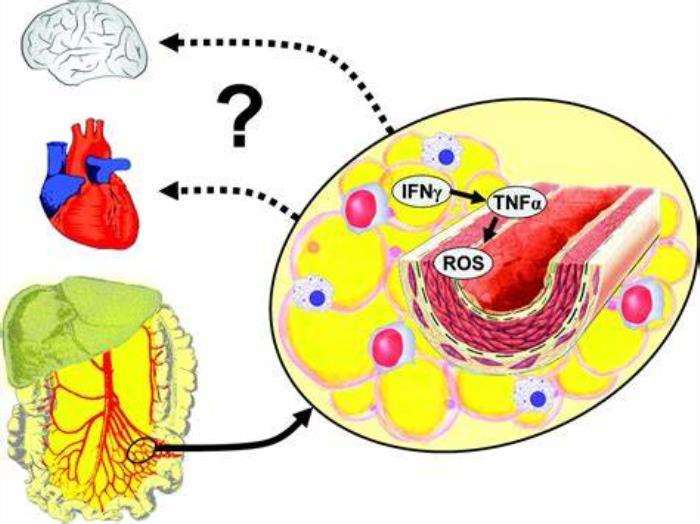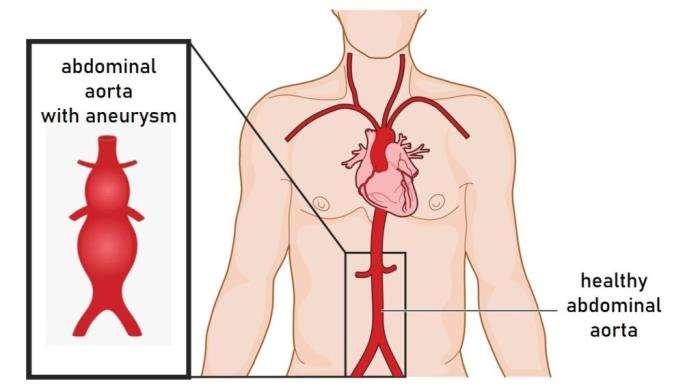An Abdominal Aortic Aneurysm (AAA) occurs when the aorta weakens and bulges in the abdominal area, posing a risk of rupture. While factors like smoking and age are well-documented risks, obesity has emerged as a significant contributor to the development and progression of AAA due to its profound effects on vascular health.
Obesity and Its Effects on Cardiovascular Health
Obesity is a major risk factor for cardiovascular diseases, exerting widespread effects on the heart and blood vessels. It is associated with systemic inflammation, lipid imbalances, and hormonal changes that compromise vascular integrity, increasing the risk of aneurysm formation and rupture.
How Obesity Contributes to Vascular Inflammation
Excess fat tissue, especially visceral fat, secretes pro-inflammatory cytokines that promote chronic low-grade inflammation. This inflammatory state accelerates vascular damage, weakening the aortic wall and creating conditions conducive to aneurysm development.

The Role of Fat Distribution in Abdominal Aortic Aneurysm Development
The location of fat deposits plays a critical role in AAA risk. Visceral fat surrounding abdominal organs exerts direct mechanical pressure on the aorta and releases inflammatory mediators, heightening the likelihood of vascular weakening compared to subcutaneous fat.
Obesity-Related Changes in Aortic Wall Structure
In obese individuals, structural changes in the aortic wall, such as collagen degradation and smooth muscle cell loss, are more pronounced. These changes reduce the aorta’s elasticity and strength, making it more susceptible to aneurysm formation and progression.
The Link Between Obesity and Hypertension: A Risk Factor for Abdominal Aortic Aneurysm
Hypertension, often seen in obese individuals, compounds the risk of AAA. Elevated blood pressure increases stress on the aortic wall, exacerbating existing weaknesses and accelerating aneurysm growth. Managing blood pressure is crucial for mitigating this risk.
Impact of Obesity on Blood Flow and Aneurysm Formation
Obesity affects blood flow dynamics by increasing cardiac output and vascular resistance. These changes disrupt normal hemodynamics, leading to turbulence and increased wall stress in the abdominal aorta, further contributing to aneurysm formation and expansion.

Metabolic Syndrome and Its Role in Abdominal Aortic Aneurysm Risk
Metabolic syndrome—a cluster of conditions including hypertension, high blood sugar, abnormal cholesterol levels, and excess abdominal fat—is a significant risk factor for abdominal aortic aneurysm (AAA). Each component of metabolic syndrome can contribute to vascular inflammation, oxidative stress, and arterial damage, accelerating aneurysm development. Addressing this syndrome holistically is essential for reducing AAA risk and improving cardiovascular health.
Obesity-Driven Oxidative Stress and Aortic Damage
Obesity promotes oxidative stress through increased production of reactive oxygen species (ROS) and reduced antioxidant defenses. This imbalance can weaken the aortic wall, contributing to aneurysm formation and progression. Additionally, obesity-related inflammation exacerbates damage to vascular structures, highlighting the need for targeted interventions to manage oxidative stress.
Does Weight Loss Reduce the Risk of Abdominal Aortic Aneurysm Development?
Weight loss, achieved through diet, exercise, or bariatric surgery, can significantly reduce the risk of AAA development. Lowering body weight reduces the strain on blood vessels, improves metabolic health, and decreases inflammation. Studies suggest that sustainable weight loss can slow aneurysm progression and reduce the likelihood of rupture, underscoring its importance in high-risk individuals.
Challenges in Diagnosing Abdominal Aortic Aneurysm in Obese Patients
Diagnosing AAA in obese patients can be challenging due to the difficulty of detecting pulsations in the abdominal region and reduced imaging accuracy. Ultrasound, the standard diagnostic tool for AAA, may have limitations in obese individuals, necessitating the use of advanced imaging techniques like CT or MRI for accurate detection and assessment.
Obesity and Surgical Treatment Outcomes for Abdominal Aortic Aneurysm
Obesity can complicate surgical treatment for AAA. Excess body weight increases the risk of perioperative complications, including infections, blood clots, and respiratory issues. Additionally, the technical challenges of operating on obese patients require skilled surgical teams and advanced equipment to ensure optimal outcomes.
How BMI Affects Recovery After Abdominal Aortic Aneurysm Surgery
Body Mass Index (BMI) plays a critical role in recovery after AAA surgery. Obese patients may experience slower wound healing, prolonged hospital stays, and a higher likelihood of complications. Comprehensive postoperative care, including dietary support and physical therapy, can help mitigate these challenges and promote smoother recovery.
The Role of Bariatric Surgery in Reducing Abdominal Aortic Aneurysm Risk
Bariatric surgery has emerged as a valuable tool for reducing AAA risk in morbidly obese individuals. By promoting significant and sustained weight loss, bariatric surgery can alleviate obesity-related risk factors such as hypertension, inflammation, and dyslipidemia, ultimately lowering the likelihood of aneurysm development and complications.
Preventive Measures for Abdominal Aortic Aneurysm in Overweight Individuals
Preventing AAA in overweight individuals requires a proactive approach that includes regular screenings, weight management, and control of associated risk factors. Lifestyle modifications such as adopting a balanced diet, engaging in regular physical activity, and quitting smoking are vital for reducing vascular stress and maintaining a healthy aortic structure.
Insights from Research on Obesity and Abdominal Aortic Aneurysm Development
Research highlights a strong correlation between obesity and AAA risk. Obesity-induced hormonal imbalances, chronic inflammation, and vascular remodeling are key mechanisms driving aneurysm formation. Ongoing studies aim to better understand these pathways and develop targeted therapies to mitigate the impact of obesity on aneurysm risk.
The Importance of Managing Comorbidities in Obese Patients with Abdominal Aortic Aneurysm
Managing comorbidities such as diabetes, hypertension, and dyslipidemia is crucial for obese patients with AAA. These conditions exacerbate vascular damage and complicate treatment outcomes. A multidisciplinary approach involving cardiologists, endocrinologists, and vascular surgeons ensures comprehensive care and improved patient outcomes.
Lifestyle Modifications to Lower Obesity-Related Abdominal Aortic Aneurysm Risk
Lifestyle changes are essential for lowering AAA risk in obese individuals. These include adopting a heart-healthy diet rich in fruits, vegetables, whole grains, and lean proteins, along with regular aerobic and strength-training exercises. Stress management and avoiding tobacco products further support vascular health and reduce aneurysm risk.
Multidisciplinary Approaches to Abdominal Aortic Aneurysm Management in Obese Patients
Effective management of AAA in obese patients requires a collaborative, multidisciplinary approach. This includes regular monitoring of aneurysm size, aggressive control of risk factors, personalized weight loss strategies, and careful planning of surgical interventions. By integrating expertise from various healthcare disciplines, patient outcomes can be significantly improved.
How Diabetes Affects the Risk and Treatment of Abdominal Aortic Aneurysm
Learn about the complex relationship between diabetes and abdominal aortic aneurysms. While diabetes may lower the risk of aneurysm formation, it complicates treatment and management due to vascular and metabolic challenges. Explore how this condition influences surgical outcomes and the role of blood sugar control in managing risks.
The Role of Cholesterol Management in Preventing Aneurysms
Discover why cholesterol management is vital for preventing aneurysms. Elevated cholesterol levels contribute to plaque buildup in arteries, weakening their walls and increasing the risk of aneurysms. This article explains how lifestyle changes, medications, and regular monitoring can support vascular health and reduce aneurysm risks.
Conclusion: Reducing Obesity to Mitigate Abdominal Aortic Aneurysm Risk
Addressing obesity is a critical step in preventing and managing AAA. Through weight loss, lifestyle modifications, and the management of comorbidities, patients can lower their risk and improve vascular health. A proactive, multidisciplinary approach is essential for mitigating the impact of obesity on aneurysm development and ensuring successful treatment outcomes.
Best AAA Surgeons in India
The Best AAA Surgeons in India are experts in vascular surgery, providing personalized care and advanced techniques to ensure effective aneurysm treatment and patient safety.
FAQ
How does obesity contribute to the development of abdominal aortic aneurysms?
Obesity increases vascular inflammation, oxidative stress, and arterial stiffness, all of which contribute to aortic wall weakening and aneurysm formation.
Can weight loss help prevent Abdominal Aortic Aneurysm in obese individuals?
Yes, weight loss reduces vascular strain, inflammation, and associated risk factors, lowering the likelihood of aneurysm development and complications.
What are the surgical challenges of treating Abdominal Aortic Aneurysm in obese patients?
Obesity can complicate surgery due to technical challenges, increased risk of infections, and slower recovery times, requiring skilled surgical teams and advanced equipment.
Is there a direct link between BMI and the risk of aneurysm rupture?
While high BMI does not directly correlate with rupture risk, obesity-related factors like hypertension and inflammation can increase the likelihood of aneurysm complications.
What lifestyle changes are recommended to manage obesity and lower Abdominal Aortic Aneurysm risk?
Adopting a heart-healthy diet, engaging in regular exercise, quitting smoking, and managing stress are key lifestyle changes for reducing obesity-related AAA risk.